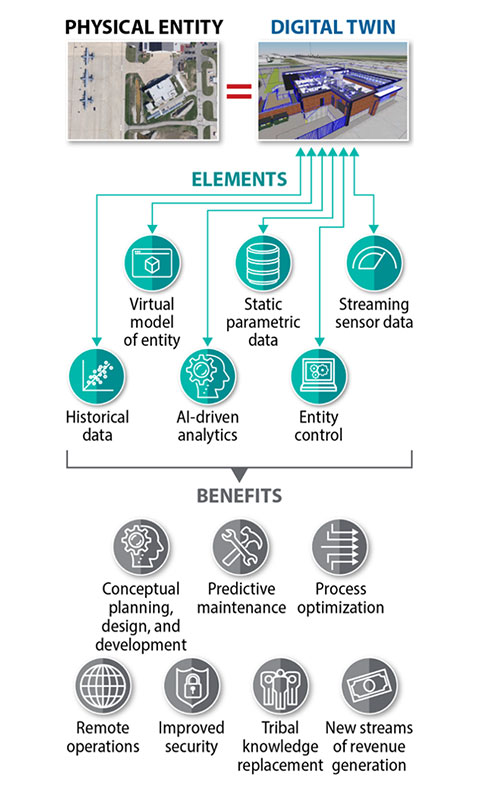
BLOG
—
Why Digital Twins? Identifying Use Cases
Digital twins provide tremendous opportunities to harness the power of elastic cloud computing, big data, Artificial Intelligence (AI), and Internet of Things to transform how organizations operate entirely. In its simplest form, digital twins can allow management-level staff to effectively direct the actions of line staff to achieve better business outcomes quicker. In its most evolved form, digital twins can operate autonomously to eliminate the need for certain line staff and potentially even management staff while still achieving better business outcomes quicker. The change in thinking brought about by digital twins represents a truly transformative means to improve business elements that can substantially increase top-line revenue and/or decrease operating costs, but how are they applied? The following sections highlight a few categories of use cases where there is significant opportunity for the application of digital twins.
CONCEPTUAL PLANNING, DESIGN, AND DEVELOPMENT
A digital twin allows designers and engineers to experiment with design concepts before executing them in the physical world. This experimentation can occur at speeds that far outpace traditional prototyping and testing by eliminating physical build steps and addressing more variables and design variations in parallel. This method results in not only decreased design and build cycle times and costs but significantly enhanced and optimized end products.
PREDICTIVE MAINTENANCE
The goal of maintenance is to ensure that equipment, facilities, or systems are operating at their highest potential performance to meet the organization's needs. Optimal maintenance strategies allow organizations to intervene at the appropriate time with the least invasive treatment to ensure the maximum serviceability of an asset, system, or facility. Traditional models (run to failure, frequency-based, usage-based, and condition-based) either completely ignore dynamic loading due to a lack of available data or try to approximate and assume the effect of dynamic loading. A digital twin can predict when an asset or process might fail with high probability due to its ability to consume enormous amounts of real-time sensor data about context, performance, and condition and employ AI algorithms. In addition, a digital twin may even be able to predict the specific manner of failure likely to occur. This predictive capability allows maintenance efforts to be applied in the most efficient way to avoid failure, reduce downtime, improve safety, optimize energy consumption, and extend asset life.
PROCESS OPTIMIZATION
Process optimization is the discipline of adjusting a process (inputs and processing steps) to optimize some specified set of parameters (outputs) without violating some constraint. The most common goals of process optimization are minimizing cost, maximizing throughput (speed), and/or maximizing efficiency (output in relation to input). Process optimization is essentially a math problem whereby evaluating more independent variables can lead to greater effect on the targeted dependent variable. As such, a digital twin’s ability to collect and aggregate data faster than humans and run complex AI optimization algorithms make it incredibly effective at this discipline.

REMOTE OPERATIONS
In addition to improving operational efficiency, digital twins can address traditional constraints related to physical proximity and transform how we manage physical assets. Digital twins, particularly when control systems are integrated, provide the opportunity for operators to run and manage assets, systems, processes, and facilities remotely. This can be a game changer when keeping staff on-site is either impractical or cost-prohibitive, but it can also be used across a wide array of applications to reduce staff sizes and costs.
IMPROVED SECURITY
This benefit category is really an extension of both design and process optimization applied specifically to security challenges. The AI of a digital twin can anticipate, understand, and react to cyber threats significantly quicker and more effectively than human-monitoring capabilities. While the increased dependence on digital networks may create or expose new risks, these same technologies are also the best weapons we have in defending their integrity. In other words, a properly built out digital twin can defend itself and an organization’s IT infrastructure much more effectively than humans can defend their own manual processes. We can create digital twins of our network infrastructures, track activity and performance in real time, and allow AI models to both anticipate and react to potential cybersecurity threats.
TRIBAL KNOWLEDGE REPLACEMENT
As the “Baby Boomer” generation approaches retirement age, the people that fueled the third industrial revolution and built and maintained our modern industrial infrastructure are leaving the workforce. We find ourselves in a precarious position where we built a significant amount of our current infrastructure ahead of the most recent advances in information technology. This means that much of the expertise and knowledge related to how specific assets, systems, processes, and facilities behave exist only within the minds of the engineers, operators, and technicians that have worked with them. One of the most significant asset management challenges organizations face today, particularly ones with aging facilities and systems, is the scarcity of this tribal knowledge. Digital twins ensure that organizations will not continue to face this same problem as we embark on the fourth industrial revolution and build new industrial infrastructure. Furthermore, to the extent that digital twins can be built for existing assets, systems, processes, and facilities, the current risk related to the scarcity of tribal knowledge can be mitigated.
NEW STREAMS OF REVENUE GENERATION
One of the most surprising and potentially attractive benefits a digital twin can provide is new revenue generation streams. By completely rethinking how we operate our critical business processes and capitalizing on the benefits of increased data capture and analysis, we are uncovering new ways that an existing business venture can generate value. Organizations are realizing that data can hold just as much value to the marketplace as the products and services they already provide. For example, an airport’s digital twin might predict increased passenger flow through specific airport areas at specific times. This data could be extremely useful to airlines, airport vendors, and passengers alike for several reasons, and, as such, the airport could sell access to these data sets. Another example is an autonomous vehicle’s ability to collect and store road condition data. This data could be incredibly valuable to transportation authorities and departments and, again, could represent a marketable data set. These are just a couple of the many examples where the data and insights generated by digital twins and AI present opportunities for new revenue streams.
PARADIGM SHIFT
In the ever-evolving landscape of digital transformation, digital twins have emerged as a powerful force, driving value across various industries. From conceptual planning to process optimization and improved security, these dynamic digital replicas have revolutionized how we approach design, maintenance, and operations. As the retirement of the Baby Boomer generation leaves a knowledge gap, digital twins rise to the challenge by encapsulating critical insights and informing decision-making in ways previously unimaginable. Moreover, digital twins unlock new revenue streams by capitalizing on the value of data, turning it into a lucrative asset. In essence, digital twins are not just a game changer; they're a paradigm shift, propelling organizations into the next frontier of innovation and opportunity.
Share this Post
